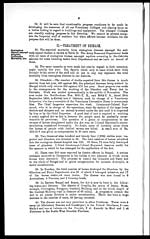Medicine - Veterinary > Civil Veterinary Departments > Annual administration report of the Civil Veterinary Department of India > 1907-1908 > Part A - Provincial administration
(18) Page 7
Download files
Individual page:
Thumbnail gallery: Grid view | List view

7
41. Surra.—There was again a very severe outbreak of this disease on the
Kathgodam-Naini Tal road in the United Provinces. 83 cases occurred
amongst the Tonga ponies and 24 cases amongst the baggage and ekka ponies.
An account of this outbreak has been already published in the Journal of
Tropical Veterinary Science. We were able to detail a Veterinary Officer to work
at the disease on the road but, unfortunately, not until late in the outbreak
and after the disappearance of the Tabanidæ which are credited with the spread
of the disease. Certain points connected with the later stages appeared to in-
dicate that the disease may be transmitted by Stomoxys and mosquitoes but the
evidence was not decisive. A point of interest in the outbreak is the fact that
experiments proved the existence of the parasite which is the casual agent in
the blood of bullocks working on the road. One positive case was found in the
only five examinations by inoculating blood from bullocks into guinea pigs
which the owners would allow us to carry out. This points to the fact that the
bullock may have formed the reservoir of the virus. A number of cases were
selected for treatment with Atoxyl and Perchloride of Mercury as well as with
Tartar emetic, but no success attended the attempt, all the ponies dying from the
disease. Arrangements have been made to post a specially selected Veterinary
Assistant on the road from the 1st April till the 1st November. We ought of
course to be able to post an officer on duty before the surra season to make
careful collections of all the biting flies and test their power of transmitting
the disease but, unfortunately, our staff is too small to allow of this being done.
It had been intended to post Mr. Martin for this duty, but he became ill and
proceeded to England on sick leave.
42. The disease was detected in six districts of Eastern Bengal and Assam,
i.e., Sylhet 43 cases, Khasi and Jaintia Hills 15 cases, Kamrup 32, Darrang
6 and Goalpara and Sibsagar 1 each. The largest outbreak was amongst the
Tonga ponies on the Gauhati-Shillong road where there were 47 cases. The
majority of these cases were diagnosed by microscopical exmination. All infect-
ed horses were destroyed to prevent spread.
43. In the Bombay Lazaretto at Sewri 73 cases were detected and des-
troyed, 39 being Arabs, 27 Australians, 1 Persian and 6 Country-breds. In
addition to this, 12 cases occurred in Ahmedabad and 13 were reported to have
died in the Thana district.
44. In the Punjab a serious outbreak occurred in the Hoshiarpur dis-
trict along the banks of the river Beas in the Dasuya tahsil, where 66 animals
died. There were 11 cases reported from Gurdaspur district, also a badly
infected one, 5 from Ludhiana and 8 from Lyallpur.
45. In the North-West Frontier Province, one case was detected in Dera
Ismail Khan and one in Kohat. The disease was very rife amongst the horses of
the Northern Waziristan Militia and the Border Military Police in the Dera
Ghazi Khan district. The disease was dealt with by the authorities concerned.
46. In the Central Provinces, the disease was reported on the Betul-Itarsi
pony dak line when half the ponies were already dead of the disease, only 32
remaining on the line. Of these, 13 were infected and 7 suspected. The act is
not in force in this province, but arrangements were eventually made with the
mail contractor to destroy the affected ponies in the blood of which parasites
were present, and the suspected ones were segregated until found free from the
disease. The measures taken were successful in stopping the outbreak and it
was possible to keep the line open with new ponies which escaped infection.
One case of the disease was discovered in Seoni and one case was reported from
Sukkur in Sind. It was also seen in horses in Manipur.
47. Endeavours are now being made to gradually map out the areas in
which Surra is enzootic and prevalent and Provincial Superintendents have
been asked to carry out this work, noting the character of the areas, whether
the disease has been diagnosed microscopically and whether it is of frequent
occurrence or not. If this be carefully done, we shall in the course of some
years be able to get some sort of idea as to distribution and incidence.
48. Anthrax.—Only 78 cases were reported to the Department in the
whole of India. Of these, 50 occurred in Eastern Bengal and Assam, 15 in
Madras and 13 in Bengal.
Set display mode to: Large image | Zoom image | Transcription
Images and transcriptions on this page, including medium image downloads, may be used under the Creative Commons Attribution 4.0 International Licence unless otherwise stated. ![]()
| Permanent URL | https://digital.nls.uk/75509480 |
|---|




